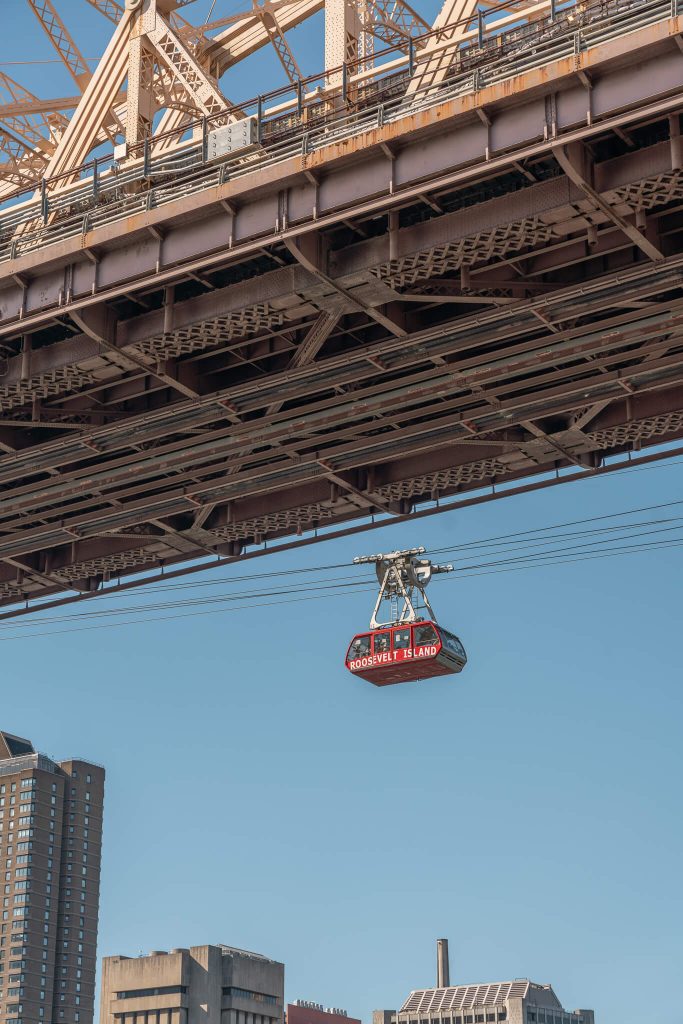Since 1898, New York consists of 5 districts: Manhattan, Brooklyn, Queens, Bronx and Staten Island, until then the city borders were only around Manhattan. The ideal would be to visit all five districts, but it’s not an easy task in such a huge city with a limited amount of time. We recommend you to throw at least one day in Brooklyn in addition to Manhattan, and in this post, we will introduce you to what to see in New York with a focus on Manhattan first.
As already mentioned – New York is a mega city and we didn’t manage to see everything in Manhattan in 9.5 days! Harlem is one of the places we will not describe in our post, but we would love to visit when next time in Manhattan. We have some other hidden treasures of Manhattan, which we will share with you if we come to visit this amazing city again 🙂
Lower Manhattan – What to see in New York?
Let’s start from where Manhattan began because it all started with a Dutch settlement on the southern tip of the island. Wall Street did not take its name out of anywhere – this is where the Dutch built a wooden wall that protected them from the north, mainly from the British. The city grew to the north with more districts, which were often slums, on the Lower East Side from 1863, tenement houses reigned, i.e. buildings in which whole families lived in small apartments, the conditions of these apartments were mostly terrible. The city expanded its borders to the entire island of Manhattan in 1863, and several decades later, the remaining four boroughs were incorporated into New York City.
It is best to start a walk around lower Manhattan from the area of Battery Park and the famous bull – Charging Bull, which symbolizes financial prosperity. They say rubbing his testicles guarantee financial success, but we haven’t tried so won’t be able to confirm. Take a stroll through Pearl Street, which takes its name from the oyster shells thrown on the ground after eating them from street vendors many years ago, to get to the famous Wall Street.
Lower Manhattan is primarily a financial district, of which Wall Street is its beating heart, there is the most important world stock exchange – the New York Stock Exchange. In front of the stock exchange building, there is the Fearless Girl statue, which symbolizes the struggle women have fought for promotions and equal pay.
On Wall Street, you will also find Federal Hall, the building where George Washington was sworn in as the first president of the United States. Easy to miss, but the four-story House of Morgan is worth noting. One of New York’s richest and greatest bankers, J.P. Morgan in times of prosperity, decided to build his bank’s headquarters with only four floors. This was to show that Morgan is so rich that he does not have to build high up and can afford a low building – then and now, the more floors, the more square meters which you can make money from.



In Lower Manhattan when exiting Wall Street you can see Trinity Church, a historic Episcopal church. It is worth noting that the first to arrive in New York were the Dutch, who were Protestants, and then the British, i.e. Anglicans.
While walking through Lower Manhattan, you can observe how the old beautifully intertwines with the new. This is where the first skyscrapers were built and you can observe a lot of impressive architecture. Don’t miss buildings like Woolworth, Municipal Building, The Trump Building and 70 Pine. City Hall building is there as well, the oldest municipal structure in New York which opened in 1812. The Faunces Tavern is the name of the oldest restaurant and no surprise you can find it there too.
In the vicinity, you will also find Stone Street, a street that looks like it’s been taken from another era, and the James Watson house, one of the oldest buildings that has survived to this day.
For views of the Brooklyn Bridge and Lower Manhattan, it’s worth heading to the Seaport, specifically to one of the piers 15-17.
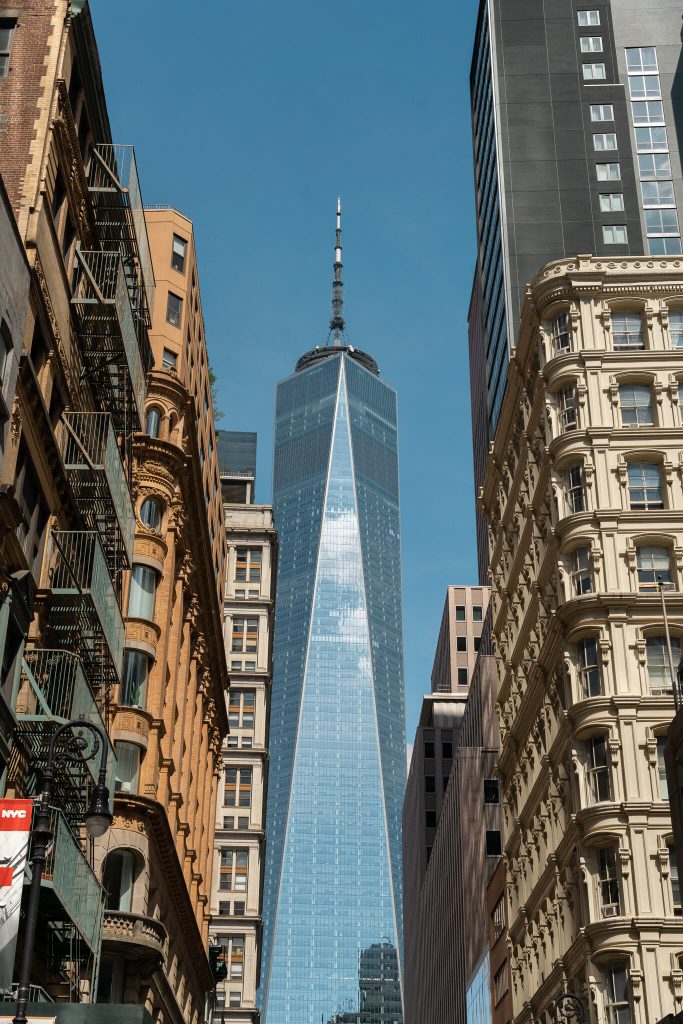

Battery Park – What to see in New York?
Battery Park is a park located at the very southern tip of the island, surrounded by tall, old skyscrapers. You can see the Statue of Liberty from the park and it’s a great spot for sunset. There is also Castle Clinton, a circular fort built in 1808 by the Americans who fortified the city’s shores due to the tense relationship between the US and Great Britain. Before the establishment of the immigration centre on Elis Island, Castle Clinton was the first immigration point in New York. The park also houses a statue of Verrazzano, the first European to reach Upper Bay.
At Battery, you will find Battery Maritime Building Slip 5, which is the last surviving building of the ferry terminal, dating back to the early twentieth century. From this building, you can catch ferries that still operate to Governor’s Island.
In Battery Park, you will also find the American Merchant Mariners’ Memorial, inspired by a photograph of a real event from World War II. The memorial depicts an attempt to rescue a drowning man at the dock.


Staten Island Ferry – What to see in New York?
Viewing the city panorama is one of our favourite activities. Of course, you can pay for a cruise around Manhattan, or you can do it for free. Just head to the Whitehall Terminal and take the free ferry to Staten Island, and another one right back. The ferry offers a beautiful view of the lower Manhattan skyline, on the way to the island it is best to position yourself in the back. The ferry also passes the Statue of Liberty, so if you do not need to see it up close, the ferry will be the perfect solution. The cruise takes 30 minutes and you can change to the return one right away. It is worth considering that it can get crowded during the week, because people travel to work on it. The sunset will be a great time, but it will probably be crowded too.

Statue of Liberty – What to see in New York?
The Statue of Liberty is unprecedentedly one of the most important symbols of New York City. Built in Paris and donated by the French to the Americans as an expression of friendship between these nations. In 1885, the finished Statue was packed and shipped in 214 containers to America. While the French took care of the Statue, the frame of which was designed and built by Gustave Eiffel, the Americans had to try to build a pedestal. The statue’s arm is raised in a welcoming gesture, it is wearing a toga, the seven spikes in the crown symbolize the seven seas, and the broken chains by its feet symbolize the fall of slavery.
For years, the Statue of Liberty was the first thing seen from the ship by immigrants arriving in New York. You can go on a cruise to the Statue, where additional payment is required to go to the top. Cruises are often combined with a visit to Elis Island, where there was an admission centre for immigrants, where they were checked (also for health) and qualified for entry to New York or sent back to Europe.
Tickets and information regarding your visit can be found here. It’s worth knowing that before boarding the ferry, you will go through a security check similar to those at airports, and it’s required to have your passport with you (they didn’t check our document, but it’s one of the few attractions with this requirement).


Manhattan Bridge – What to see in New York?
Definitely less crowded than the famous Brooklyn Bridge, but worth the walk in our opinion (take the path on the Lower Manhattan side for the best views). We recommend especially when it is dark to admire the panorama of illuminated Lower Manhattan. The footpath is on the sides and there is a carriageway and railroad tracks in the centre. The view is obscured by the mesh, but in the best spots the photographers made holes in it to be able to take photos.
Going from Brooklyn to Manhattan at the end of the bridge (following the path on the left) you can see Chinatown, and right next to the bridge there are buildings and you can often see microscopic apartments and the terrible conditions in which a large part of the New York population lives. It’s just a reminder that New York is not only glamour but also a lot of people barely making ends meet.


Museum and 9/11 Memorial – What to see in New York?
In the northern part of lower Manhattan, there were two towers of the World Trade Center, which collapsed after the attacks of September 11, 2001, a day that many of us remember. Currently, exactly in the place where the towers were located, there are two pools that eloquently commemorate the victims of the attacks and are called the 9/11 Memorial. Water constantly flows from the walls of the pools, the names of all the victims are engraved on the plates surrounding the pools. Entry to the memorial is free. Between the memorials, there is a survival tree, a tree that miraculously survived the attacks unharmed. Right next to it, you will also find the FDNY Memorial Wall, a wall commemorating all 343 firefighters who perished in the tragedy.
If you are interested in the history of attacks, and there were as many as 4 on September 11, we recommend going to the 9/11 Museum. You can buy tickets here, and in the museum itself, it is worth going for an audiobook. The Historical Exhibition of September 11, 2001 shows a lot of material from the day of the attacks, including videos, about the very history of the buildings, as well as the consequences of the attacks. You cannot take photos or videos in this part of the museum. It is worth devoting at least 2-3 hours to the museum, because there are many exhibits, descriptions and history to explore there.
Near the 9/11 museum and memorial, there are two other interesting places – the Winter Garden, which is an indoor garden within the shopping center, and the Irish Hunger Memorial, a monument commemorating the Great Famine that struck Ireland in the 19th century and led to a mass influx of immigrants to the USA.
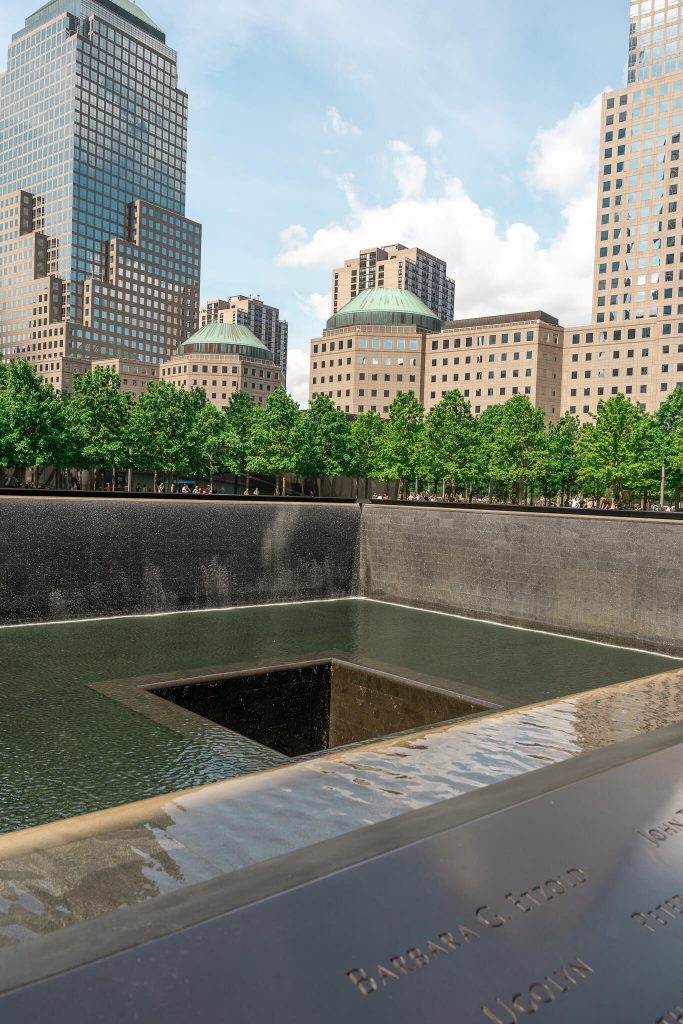

Right next to the memorial and museum, The One World Trade Centre (known also as Freedom Tower) was built, the name of which is the same as the name of the north tower that collapsed. I must admit that few modern skyscrapers impress us as much as the beautifully reflecting light The One pane. In addition to The One, the Oculus was also built, an extremely aesthetic and harmonious architectural work designed by Santiago Calatrava. The Oculus has a PATH train station (which connects you to Jersey City), a subway, and a shopping mall. The idea behind the construction of these buildings was to restore the site of attacks by life and people.

TriBeCa – What to see in New York?
TriBeCa, whose cryptic name is simply short for Triangle Below Canal Street, is one of the most expensive and fashionable neighbourhoods in New York City. We liked it very much, especially its industrial atmosphere, because in the past it was an industrial district, and over time factories were converted into fashionable lofts and apartments. We like the contrast of multi-storey red brick tenement houses with modern skyscrapers like The One in the background. On White Street, you will see excellent examples of cast-iron architecture, characteristic of TriBeCa and the nearby SoHo.
Two buildings worth paying attention to are the Jenga Building (officially 56 Leonard), which resembles the shape of the Jenga game, and 33 Thomas Street. The latter is also known as “The Windowless Building,” the only building in New York City that is not illuminated at night, designed to survive an earthquake, nuclear attack or terrorist attack. It belongs to AT&T (it was called the AT&T Building in the past) and is most likely a telephone exchange or wired centre building, although no one knows for sure. There are, of course, a lot of conspiracy theories around the building regarding spies and surveillance. To the north of TriBeCa is Hudson River Park, a linear park along the Hudson River where residents enjoy running and walking their dogs.



Chinatown – What to see in New York?
Manhattan’s Chinatown is one of the oldest in America and also the most densely populated Chinatown in the Western Hemisphere. However, it is not the largest in New York – the largest is in Queens, and its name is Flushing. In Chinatown you will find Chinese restaurants and businesses, you can easily eat dumplings, Chinese noodles or duck there and move to a different world for a moment. In Chinatown is Doyers Street, the bend in this street was known as “The Bloody Angle” in the past. It has to do with the bloody gang activity in Chinatown that lasted until the 1930s.
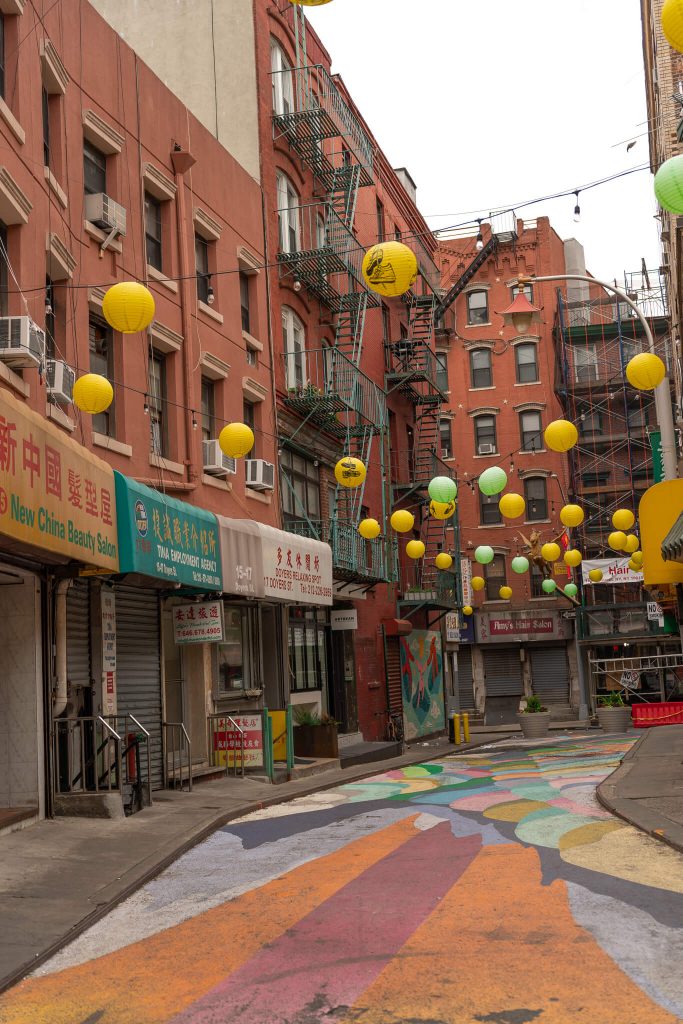

Little Italy – What to see in New York?
Another historically ethnic district is Little Italy. While Chinatown is still dominated by the Chinese / Asian population, Italians from Little Italy have long since scattered around Brooklyn and Queens, mainly due to high rental prices in Manhattan. You will still find Italian pubs there, but apparently it is harder and harder to find really authentic and good ones. Although there are fewer and fewer Italians, on September 19, the San Gennaro festival is still celebrated there.

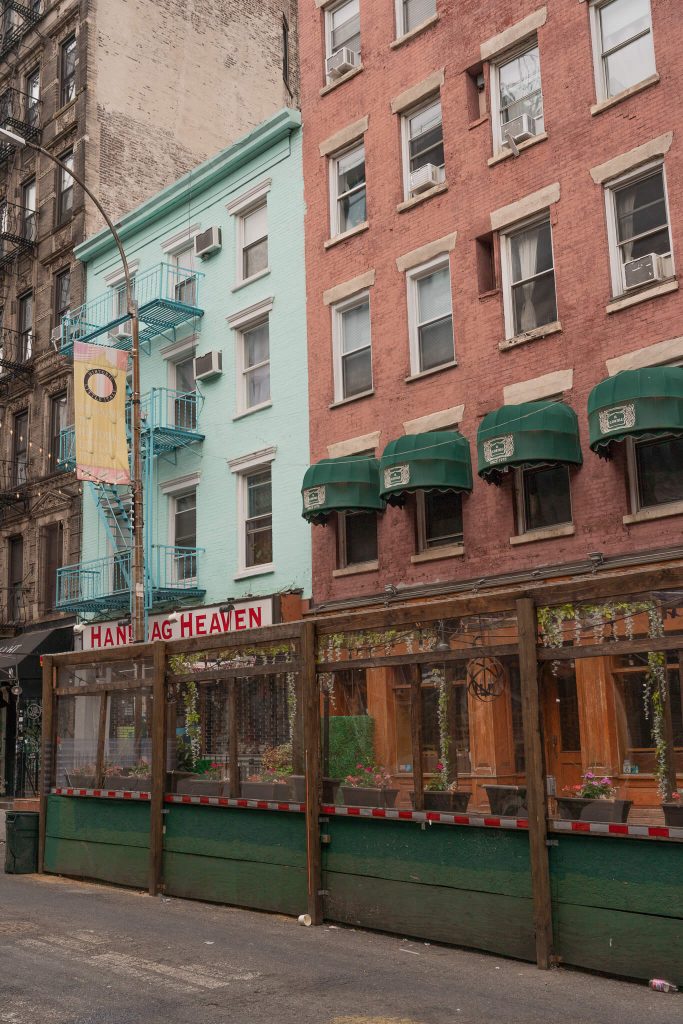
SoHo – What to see in New York?
Another of New York’s exclusive neighbourhoods with an industrial past, its name stands for South of Houston Street. Similar to TriBeCa, it is a post-industrial district where there used to be factories in the past that were later converted into lofts and apartments. It used to attract bohemians and artists (now it is probably too expensive for them), now rather wealthier inhabitants of the city. SoHo is famous for its Cast-Iron architecture, cast iron decorations were used to finish the facades and can be seen in many places. A great example of this type of architecture is E.V. Haughwout Building. Today SoHo is sky-high lofts, designer boutiques, niche brands, vintage shops, quaint cafes and expensive restaurants.


NoLiTa – What to see in New York?
NoLiTa (North of Little Italy) may be a slightly less mentioned sister of SoHo, but it is still a luxurious district with a similar atmosphere to SoHo. In NoLiTa you will find Elizabeth Street Garden, which is one of the many small public gardens and parks hidden between the buildings. The squatters, a group of people who occupied abandoned buildings and unwanted gardens in the 1980s and 1990s, renovated them, and as a thank you, the city gave a large part of it to them. Unfortunately, this extraordinary place is facing the plans to build another skyscraper again…
Lower East Side – What to see in New York?
The Lower East Side is a place with an uninteresting past because this is where the infamous tenement houses existed, where immigrants who came to New York lived in inhuman conditions, huddled like chickens in their roosts. A large part of the Lower East Side’s inhabitants were Jews, and to this day there are many Jewish restaurants and shops there, such as Katz Delicatessen or Yonah Schimmel.
The Lower East Side is also home to tons of speakeasy bars including The Back Door, one of two in New York City that has survived since Prohibition. The district’s nightlife is rich, and there are plenty of trendy eateries that aren’t as expensive as in other parts of the city. The Lower East Side is alive, becoming more and more fashionable and popular, and in the future, it will probably share the fate of other parts of New York and will become a place for the wealthy chosen ones who can afford to live in this area…
More about LES you can find in this post.
Greenwich Village – What to see in New York?
Greenwich Village, also known as West Village, or simply Village, is the only part of Manhattan where streets do not follow a grid pattern. The buildings in the Village are rather low, and from the mid-nineteenth century, bohemianism began to draw into Greenwich Village. Famous writers and painters such as Mark Twain, Edgar Allan Poe and Jackson Pollock settled in the area. After the artists came to Greenwich Village, the city’s wealthier citizens came, and the neighbourhood gentrified and are now one of the city’s most desirable addresses, full of boutiques, cafes and restaurants. A place that cannot be missed is Washington Square Park with its triumphal arch, which in the past was… a cemetery. You can meet many students in the area because the New York University campus buildings are located around the park.
In Greenwich Village, you can see the facade of the building that was used as Monica and Rachel’s apartment in Friends (90 Bedford St), which we think makes a bigger impression on the series than live (there are simply more beautiful buildings in the city). As well as the famous Carrie Bradshaw apartment from Sex in the Big City (66 Perry St) and Magnolia Bakery, who is also known from the series.
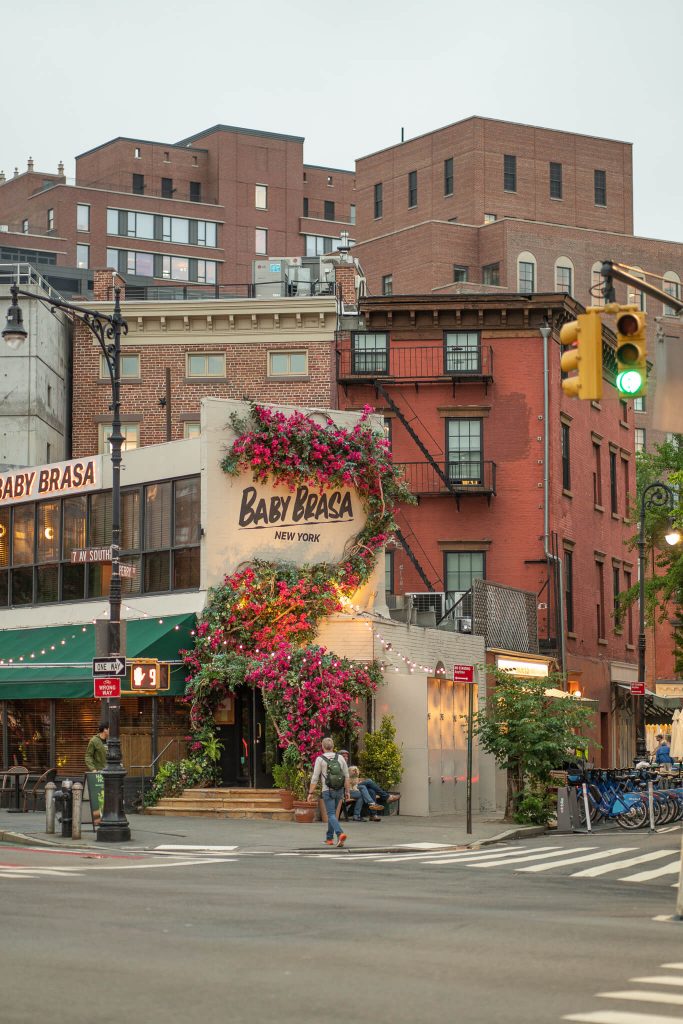

Union Square – What to see in New York?
Union Square is one of the many small parks in New York City. If you are going shopping, it might be a good idea to do it here, because around Union Square and in the neighbouring streets there are many nice shops.
Madison Square Park and Flatiron – What to see in New York?
Madison Square Park is not far away, but we liked it more than Union Square, probably because it is surrounded by beautiful buildings. Give some attention to One Madison Ave with a beautiful clock tower and the New York Life Building crowned with a golden tip. The most important around Madison Square Park, however, is the Flatiron, a 22-story, the triangular building named after it resembles an iron. At its narrowest point, it is only 2 meters! The Flatiron is an impressive building, although we were unlucky enough to settle for the scaffolded view.


Gramercy Park and Gramercy – What to see in New York?
Gramercy Park is the only one in Manhattan and one of two private parks in New York. Only residents of nearby tenement houses have the keys to it if they pay the appropriate “rent”. The empty park is a bit of a sad sight, but we understand the residents’ need for privacy. The district was in the middle of a swamp that had been drained to create a park, and construction of the surrounding buildings began later. Numbers 1 to 4 of Gramercy Park are original tenement houses built between 1844 and 1850. Gramercy is a quiet, clean and quite affluent area
Chelsea – What to see in New York?
It looks like, we like the districts with industrial DNA the most, and it’s no different in the case of Chelsea. Chelsea’s industrial history began in 1847 with the Hudson River Railroad separating Chelsea from the Hudson River embankment. The railway line helped the development of industry, there were distilleries, breweries, plants producing fuel for lamps, and wood yards. The Manhattan Gas Works complex, which converted coal into gas, also operated there. The development of industry attracted poor immigrants, especially the Irish, and rent-houses were built.
Chelsea today are the red brick buildings that house the luxurious lofts and art galleries for which the district is famous. When writing about Chelsea, one cannot ignore the famous Hotel Chelsea, which was chosen and loved by writers and artists. Among them, we can mention Mark Twain, Jack Kerouac, Stanley Kubrick and Jim Morrison.


Chelsea Market – What to see in New York?
In the past, the building that now houses Chelsea Market was the site of the Nabisco factory, which at that time was producing the popular Oreo biscuits and was the biggest sweets factory in the world. Now we have a two-level market where you can find some souvenirs, but the main focus is on food. You will find a lot of pubs there and it is worth trying at least a few. Before visiting, check the opening hours, because while the market opens early, the pubs only are around 11. We recommend Lobster Place for oysters and lobster sandwiches, and Dickson’s Farmstand Meats for a hot dog.
Little Island – What to see in New York?
Little Island is one of the newest projects in New York. It is a park located on an artificial island in the Hudson River. In our opinion, this is a brilliant interactive project! The park is small but recessive, it is in the “wild” garden trend, full of lavender and insects. Its external structure and inverted white bells are also impressive.

High Line – What to see in New York?
The High Line is another innovative park, the construction of which was carried out in three stages and began in 2009 and ended in 2019. The High Line saved the New York Central Railroad, which towers over the streets of New York, which, abandoned over the years, were deteriorating. We owe the idea of transforming into a park and saving the tracks from demolition to two gentlemen – Joshua David and Robert Hammond founded the Friends of High Line organization and somehow convinced the city and investors to this brilliant project.
The High Line begins near Vessel and leads through one of the newest Hudson Yards estates, along the way you can admire modern buildings, including 520 West 28th designed by Zaha Hadid. The park passes through the west side of Chelsea and ends at Chelsea Market. The ideal option is to start your walk by seeing Vessel in the early morning and then continue towards Chelsea Market. It will be calmer and looser in the morning, and you can drop by for breakfast at Chelsea Market! The park is full of volunteers caring for plants and also willing to chat about this extraordinary place.
An interesting fact is that a trial project called Low Line was also carried out in Manhattan. In the former trolley terminal at the Williamsburg Bridge, the world’s first underground park was piloted in which artificial lighting was to keep plants alive. Unfortunately, due to a lack of funds, the project was abandoned in 2020.


Vessel and Hudson Yards – What to see in New York?
Hudson Yards is a massive undertaking and virtually a new neighbourhood in New York City. There are skyscrapers housing apartments, green spaces, shops and restaurants. The Hudson Yards includes the 30 Hudson Yards building at the top of which is The Edge observation deck, the triangular platform extends from the body of the building, and the biggest attraction is the glazed floor. Hudson Yards is also a Vessel, a torch-shaped viewing platform that can currently only be admired from the ground floor. Several suicides were committed from the top of the building, and authorities concluded that security measures were inadequate and closed the platform to visitors.
You can learn about our opinion on The Edge, as well as other observation decks, here.


Empire State Building – What to see in New York?
The Empire State Building has been a slap in a face for Chrysler’s building completed a year prior. Why? Chrysler was accused of “cheating” to become the tallest building in the world a small deception in the form of installing a 60-meter spire. Because of this, the last floor of the Empire State Building is located higher than mentioned spire, which meant in 1931 ESB was not only the highest building in New York but also in the world. It is now the third building in the states and the fifth in the world. Interestingly, after the WTC towers collapsed, In 2001, ESB regained the title of being the highest in NYC for some time.
After completion, it was called Empty State Building due to the fact it was mainly empty until the forties as there were no candidates to rent spaces. The building is designed in the art deco style and has a beautiful interior. If you want to see New York from above, go to the observatories located at 86 and 102. From the observation decks, you will see the beautiful Chrysler Building, but you cannot see the best from there – the Empire State Building itself 🙂


Chrysler Building – What to see in New York?
If we are naming the most beautiful buildings of New York you cannot miss the stunning Chrysler building designed in art deco as well. Its interior, unfortunately, cannot be admired by tourists. The top is designed to resemble Chrysler’s car engine as well as other car parts, also pay attention to eagle gargoyles stocking out the corners.


The Morgan Library and Museum – What to see in New York?
As we have already mentioned in the story of the Financial District, Mr J.P. Morgan was an outstanding financier and businessman. He gathered a sizeable books collection and the audience can now see it in what is called the Museum and the Morgan Library. The entire collection, as well as the interiors in which it is set, is impressive. Free entry on Friday afternoons, but pre-booking is essential.


Bryant Park – What to see in New York?
One of the many parks in the city centre, it might seem inconspicuous. Bryant Park is located by a monumental public library building and is surrounded by high-rises soaring upward skyscrapers. It might seem like another ordinary park, but Bryant Park has that “something” about it, the park is just always alive! At lunchtime, you will see swarms of office workers eating lunch there, especially since the park is full of chairs and benches where you can consume take-out food. There are also chess tables, a cafe and a small pub. If you want to observe New Yorkers in their “natural environment” then Bryant Park is a great choice!

Public Library – What to see in New York?
The public library was created thanks to a visionary, Governor Tilden, who donated his fortune to create it. At that time, there were two other libraries in the city and, following in Tilden’s footsteps, Astor and Lenox donated their collections for this purpose. This is how the foundations of the site, which is now one of the largest public libraries in the world, were laid. The book warehouse was placed under the floor in the basement, the books were transported on carts with the help of horses. At that time, such an innovative system of cataloguing and distributing books was used that it was considered the most modern in the world, and Mr Tilden assumed that no one would wait for a book in his library for more than half an hour.
We wanted to see room 315, Rose Main Reading Room, which unfortunately can only be visited by people who read/do research, and we told the guard that we did not intend to do so. Next time we’ll stop by to read and spend more time there!
Grand Central Terminal – What to see in New York?
It is a station through which thousands of suburban rail passengers pass every day, and there is also an underground station under the main station. It was put into service in 1871 when the railways were in their prime. The stately marble interior of the station’s main hall is adorned with a vault painted like a sky with numerous star constellations. While in Grand Central Terminal, you cannot miss the Whispering Gallery, which is located right in front of the entrance to the Oyster Bar restaurant, which in our opinion deserves more attention than the gallery itself. You will eat there Manhattan chowder, delicious oysters from all over America, as well as many other kinds of seafood.
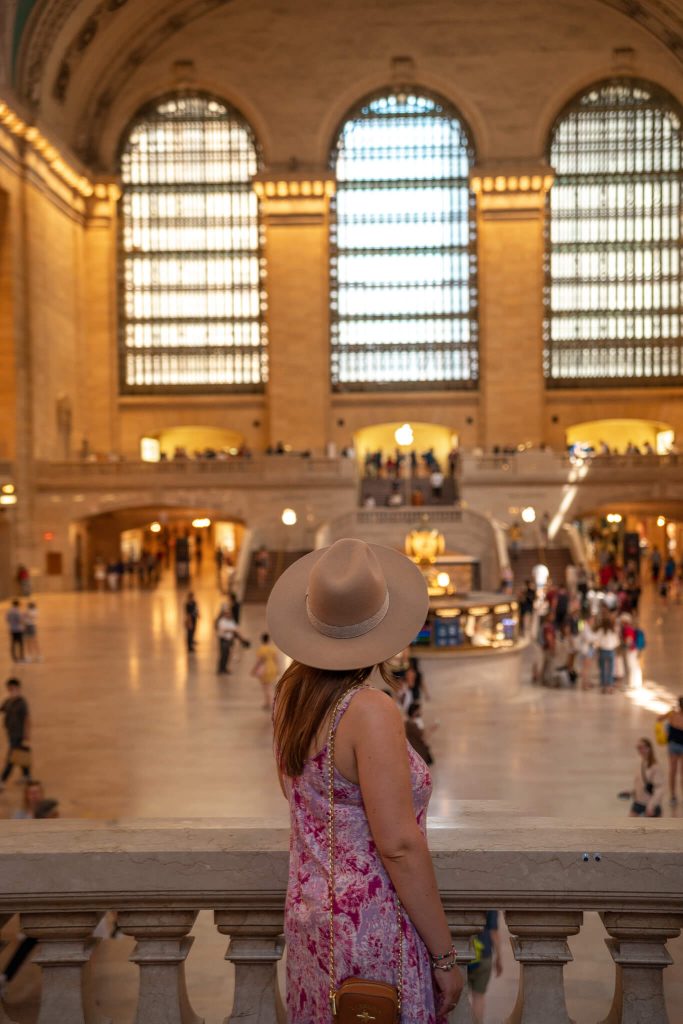

Koreatown – What to see in New York?
Everyone knows Chinatown and few know Koreatown. And it’s hardly surprising as Koreatown is not that spectacular and takes only two blocks right next to the Empire State Building. However, if you would like to try Korean-style grilled dishes, you know where to go.
Times Square and Theatre District – What to see in New York?
Full of people, cars, and lights flashing from huge Times Square billboards, I don’t think you need any introduction. The heart of the Theatre District and a place where New Yorkers grimace and treat it as a “necessary evil”. As tourists, however, we could not miss it.
Times Square replaced “Longacre Square” when the famous New York Times newspaper moved its headquarters there. Today, the headquarters of the New York Times is located in a different location nearby, but you can still admire the famous One Times Square, the former headquarters of the newspaper. It is from this building that the famous New Year’s ball is dropped every year on New Year’s Eve. The history of Times Square, which runs from the heyday of theatres, through the breeding ground of the porn industry, to the present form, could be told for hours. In our opinion, it is worth stopping by for a moment and then evacuating to nicer places, in that area, apart from the crowds of tourists, there are, unfortunately, also a lot of homeless people and drug addicts.
Being in this area, you cannot forget about the theatres still operating there, one of the most interesting buildings (all known from Kevin alone in New York movie) is Radio City Music Hall.
In our opinion, a stay in New York cannot be complete without visiting Broadway and watching one of their famous shows! You can buy tickets in advance, but if you want to save, it’s best to buy them the same day at the TKTS box office in Times Square (other box offices closed due to the pandemic, but check if anything has changed) for the evening or midday performance the next day. Another trick is looking for cheaper tickets directly in theatres, there are lotteries that you can register for online, and sites that sell last-minute tickets (make sure it’s not a scam!). We bought it at the TKTS ticket office and we recommend this method, although you have to queue a bit …


Rockefeller Centre and Top of the Rock – What to see in New York?
Many of us associate Rockefeller Centre with the Christmas tree and the ice rink in front of it. Well, Rockefeller Centre is not one building, but a whole complex consisting of 19 buildings spread over 3 blocks. The most famous one facing the Christmas tree is the Comcast Building (30 Rockefeller Plaza). The complex includes offices, a shopping mall, numerous restaurants, as well as Radio City Music Hall.
When visiting Rockefeller Centre, you cannot miss New York’s best observation deck – Top of The Rock. Why the best? Well, it is the only observatory on the upper terrace of which you can admire the city without restricting glass panels or bars, and secondly, it is the best vantage point to see Central Park and no other observatory has such a central view of the Empire State Building.
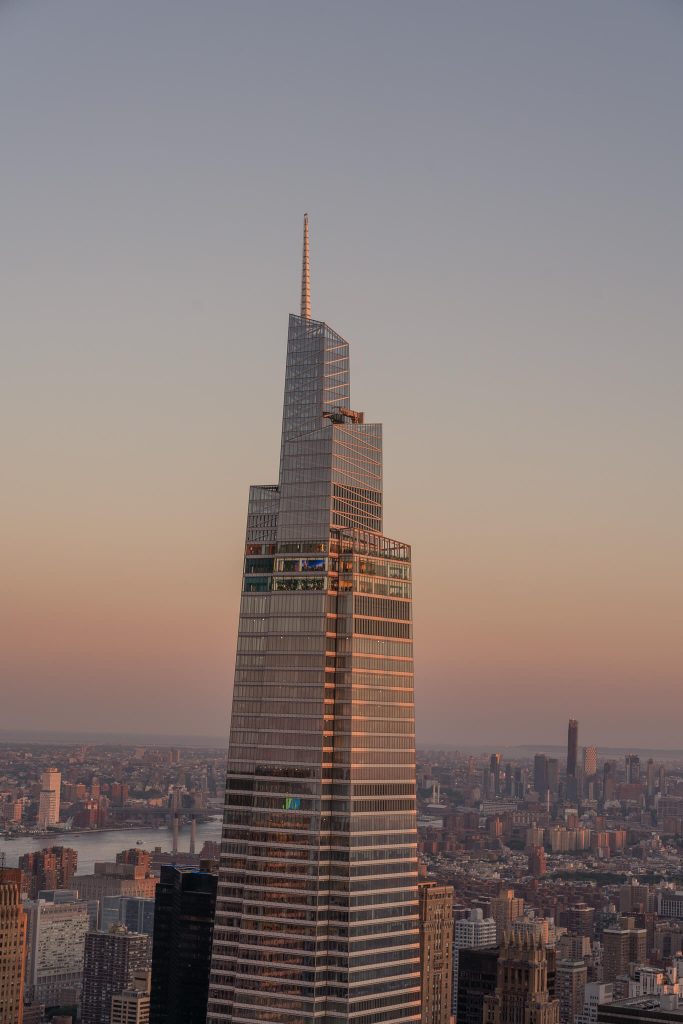

Fifth Avenue – What to see in New York?
5th Avenue is probably known to everyone from movies, it is an avenue of luxury where boutiques of the world’s most expensive designers are located. The splendour can be felt most in the area of Rockefeller Centre and it stretches along Central Park. It is home to the famous Tiffany boutique from the movie Breakfast at Tiffany’s. When you stroll down Fifth Avenue, you can’t miss the beautiful, neo-Gothic St. Patrick’s Cathedral, the seat of the Archbishop of New York.


Columbus Circle – What to see in New York?
Columbus Circle is basically a huge roundabout located at the southwest end of Central Park. Its name comes from the monument of Christopher Columbus in the centre. It is said that this is where the distance to the city of New York is measured. If you take a walk from Columbus Circle along the southern border of Central Park (that’s where Billionaire’s Row is), you will reach the famous (including Kevin alone in the New York movie) Plaza Hotel and the square with the Pulitzer Fountain (yes, this gentleman from the Pulitzer Prizes, he was the founder of the fountain).
Central Park – What to see in New York?
A true work of landscape architecture, which as a discipline was incidentally “created” by the creators of Central Park. Before the creation of the park, the areas in which it is located were swampy and uninviting, if anyone saw greater potential in them, the park would probably have been developed with buildings to the centre. Fortunately, that didn’t happen, and New York City has its huge green lungs.
Federick Law Olmsted and Calvert Vaux became the park designers after winning the competition for the best park design. Their design was extremely innovative and assumed that the naturally occurring rocky hills should be integrated into the park. In addition, the park is “multidimensional”, it has been designed in such a way that, without closing it overnight, there is no need to stop traffic, and road traffic does not interfere with pedestrian traffic. The streets that cross the park are below, with pedestrian bridges over them, so densely planted that the cars below are easy to miss.
The park is divided into three parts – the northern one, located at the Jackie Kennedy-Onassis reservoir, the middle one between the reservoir and “The Lake”, and the southern one, located below the lake. Particularly noteworthy is The Ramble, the wildest part of the park that resembles a forest. It is a mecca for birdwatchers, and the number of interesting species in the city may be surprising. Noteworthy in the park, apart from the places already mentioned, is the lake “The Lake” where you can rent a boat, Bow Bridge, from which you can admire the San Remo building, the terrace and the Bethesda fountain, as well as Strawberry Fields – a place in honour of the murdered nearby John Lennon. From the Gapstow Bridge, there is a great view of Billionaire’s Row and the Plaza Hotel.
We recommend spending at least half a day in the park, taking a walk, observing, having a picnic and eating a hot dog from a cart. This place really has that magic that everyone’s talking about.

The MET Museum – What to see in New York?
The Metropolitan Museum of Art is a great place to combine with a visit to Central Park, after hours of sightseeing, you will be relieved to have the opportunity to rest in the park. The MET is huge and the collections are overwhelming and it’s really hard to digest it all in 3 or 4 hours (especially if, like Aneta, you do not like museums). If you are a museum lover, go ahead and plan your whole day there, if not, the best option is to do good research and decide what interests you the most. Unfortunately, in our opinion, logistics and moving around the building are not the easiest task.
During your visit, don’t forget to visit the roof garden with an excellent view of Central Park! When mentioning the MET, it is also worth adding something about their second Cloisters location, which is located in North Harlem, it used to be one ticket to visit both places, but now the website suggests something else …

Upper West Side – What to see in New York?
The Upper West Side is on the west side of Central Park. You can start your walk on Columbus Circle and go to Lincoln Centre, where the Metropolitan Opera is located (in fact, this area is called Lincoln Square, UWS is a little further north). The Upper West Side has a nice, relaxed atmosphere, there is no shortage of cafes, but also an old-fashioned deli, where you can eat a sandwich, bagel or pancakes for little money. This part of New York is still one of the more prestigious and expensive ones, but it has a lot more slack than the Upper East Side.
When walking around UWS, be sure to go to the Dakota Building, the building where Joko Ono lived and John Lennon was murdered nearby. Right next to it is the prestigious, beautiful San Remo, which has its twin, El Dorado a bit more north. Between 71 and 87 streets there are beautiful old tenement houses called ‘brownstones’.


Columbia University – What to see in New York?
When in the Harlem or Upper West Side area, you can walk and walk through the campus of Columbia University founded in 1754 (then known as King’s College). It is a private university belonging to the prestigious Ivy League. As it is easy to guess, such a prestigious university has educated a group of famous people, from the Roosevelts through Barrack Obama to Jack Kerouac.
Upper East Side – What to see in New York?
The Upper East Side disappointed us a bit, but it’s quite possible that our wild imaginations were pumped up by filmography and contemporary literature. The Upper East Side is one of the richest, most luxurious neighbourhoods in New York, home to a conservative New York aristocracy for decades, uninterested in fashionable, hipster places. Why did it disappoint? We thought it would be simply “prettier”, and in our opinion, this is the neighbourhood on the other side of Central Park, the Upper West Side. Nevertheless, we recommend you to take a walk there and judge for yourself whether you like it or not!
In the Upper East Side, it’s worth taking a walk through Carnegie Hill, the wealthiest part of the district. If you enjoy museums, be sure to check out the Guggenheim Museum, which is visually striking even from the outside due to its unique shape. Gracie Mansion Conservancy is a historic estate that serves as the mayor’s residence in New York City.
Roosevelt Island and Ed Koch Queensboro Bridge – What to see in New York?
It is not Manhattan itself, but from Manhattan, you can get there, and this place is so unusual that we have to devote at least a scrap of this post to it. Roosevelt Island, a long but narrow island, is accessed from Manhattan by the Roosevelt Island Tramway. It is a cable car suspended from the Queensboro Bridge and the cable car is an attraction in itself. The queue is free for holders of time cards for the subway, and if you have a card for “journeys”, the ride will cost you $ 2.75, which is as much as one ride on the subway.
The island itself is quite unusual, it is inhabited, and there are quite a few residential buildings there, but not much is going on there. You will not find a real market there, and only a few, expensive food stores, restaurants or bars are also not many. On the southern tip of the island are the ruins of the smallpox hospital and Franklin D. Roosevelt Four Freedoms State Park. There is a lighthouse on the northern side. If you are planning a visit, it is worth getting some snacks and having a picnic there.

